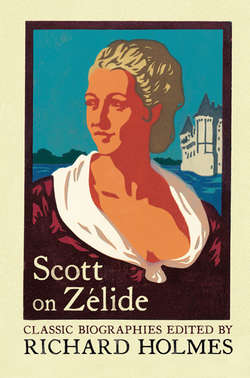Читать книгу Scott on Zélide: Portrait of Zélide by Geoffrey Scott - Richard Holmes - Страница 6
2
ОглавлениеIf it was an unusual situation, then Isabelle de Tuyll (known by the local landowners as ‘Belle de Zuylen’) was a thoroughly unusual young woman. If not exactly beautiful, she was extremely attractive and drew glances wherever she went. She had a full, open face, with large green eyes and wild auburn haired brushed impatiently back from a high forehead. She was tall, commanding, full-bosomed, and restless in all her movements. She was not only an accomplished harpsichord player (and composed her own music), but also an expert shuttlecock player, quick and determined in her strokes, with an almost masculine speed and self-confidence.
Isabelle de Tuyll was also unusually well-educated. Her liberal-minded father, recognizing the exceptional talents of his eldest daughter, had spared no expense. As a girl she was given a clever young governess from Paris, Mlle Prevost, and she was soon studying French, Latin, Greek, mathematics, music, algebra, and astronomy. Later she was tutored by a mathematics professor from Utrecht university. She took a particular delight in reading Voltaire and calculating conic sections. She once remarked nonchalantly: ‘I find an hour or two of mathematics freshens my mind and lightens my heart.’
By the time she was twenty in 1760, Isabelle de Tuyll was being besieged by suitors, proving particularly attractive to rich Dutch merchant bankers and penniless Germain princelings. But now she was too quick and clever for most of them. They bored or irritated her. The first time she ever saw the Chevalier d’Hermenches, at the Duke of Brunswick ball in the Hague, typically she broke all the rules of etiquette by going straight up to him and asking ‘Sir, why aren’t you dancing?’ At first he was deeply offended, then quickly charmed. ‘At our first word, we quarreled,’ he said later, ‘at our second, we became friends for life.’ It was soon after that their clandestine correspondence began.
Though admired by her younger siblings (and adored by her brother Ditie), her parents now thought of Isabelle with increasing anxiety. In the salons of Utrecht and the Hague, she was getting the reputation of a belle esprit, an unconventional free spirit, a rationalist, a religious sceptic: in short, a young person of ‘ungoverned vivacity’. This was all very well for a man, but perilous for a young woman. She might never marry and settle down. Her name ‘Belle de Zuylen’ was now spoken with a certain frisson.
To confirm these worries, Isabelle soon began to write poems, stories and essays. In 1762 she published her first and distinctly rebellious short story, ‘Le Noble’, in the Le Journal Etranger. It described a young woman eloping with her lover from a moated Dutch castle, under the disapproving gaze of the ancestral portraits. In fact the ancestral portraits are literally stamped under foot, when they are thrown down to form a kind of pontoon bridge over the moat, across which the young woman dashes to freedom one summer night. This work set tongues wagging in Utrecht.
Soon, more daring, she wrote and circulated among her friends her own deliberately provocative self-portrait. It was now that, perhaps inspired by Voltaire, Isabelle de Tuyll invented her own literary pen-name: the sinuous, satirical, and distinctly sexy ‘Zélide’. (Like Voltaire’s adaptation of his family name Arouet, ‘Zélide’ seems to have been based on a sort of loose anagram of her nickname, ‘Bel-de-Z’.)
She described Zélide as follows:
You ask me perhaps is Zélide beautiful?…pretty?…or just passablê I do not really know; it all depends on whether you love her, or whether she wants to make herself lovable to you. She has a beautiful bosom: she knows it, and makes rather too much of it, at the expense of modesty. But her hands are not a delicate white: she knows that too, and makes a joke of it…
Zélide is too sensitive to be happy, she has almost given up on happiness…Knowing the vanity of plans and the uncertainty of the future, she would above all make the passing moment happy…Do you not perceive the truth? Zélide is somewhat sensual. She can be happy in imagination, even when her heart is afflicted…With a less susceptible body, Zélide would have the soul of a great man; with a less susceptible mind, with less acute powers of reason, she would be nothing but the weakest of women.
This delightful tangle of self-contradictions, these ‘feverish hopes and melancholy dreams’, these struggles with role and gender, form the heart of Zélide’s early correspondence with the Chevalier d’Hermenches. They are not exactly love letters. But they are highly personal, intense, and sometimes astonishingly confessional. They also leave room for a great deal of lively discussion of local Utrecht gossip, scandal, marriage schemes, reading, and what Zélide called her ‘metaphysics’. Above all, they discuss the future. What is to become of Zélidê
